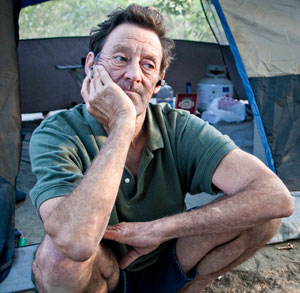

I am standing just outside San Jose City Council Chambers, looking at garbage. Literally. Photos of Coyote Creek grace the walls of the curved wing at City Hall. Sculptures comprised of garbage extracted from the creek emerge from pristine white pedestals.
Designs of Highways 280 and 680 and the creek are pasted onto the walls, designating the beginning and end of the new exhibit whose title says it all: “Welcome to Coyote Creek.’
The exhibit, by its own words, explores the “best and worst aspects’ of our “largest riparian habitat and park, Coyote Creek.’ The show purports that the creek and its multiple pieces of hidden trails can be seen as a microcosm of San Jose itself.
In the show, the very funny welcoming statement is written from a perspective many San Jose artists know very well. That is, it exudes sardonic wit and thinly veiled embarrassment at the suburban apathy and belligerent lack of curiosity toward one’s own surroundings imprinted in the majority of San Jose’s populace.
“What is Coyote Creek?’ It asks. “Well, you drove by it on your way to work today. You may have cast a sandwich wrapper out the window that now swims in it. You caught a fleeting glimpse of a green park sign about it, and thought, ‘What on earth is that?’ The oil leaking from your car onto the road flows into it. But you most likely never walked it. We did, and we would like to share what we found.’ Bravo.
In case you haven’t explored our hidden exotic gem, the creek twists and turns its way over a 60-mile track from above Morgan Hill and then through park lands, underneath freeways, alongside schools and industrial warehouses.
The river passes by opulent golf courses, blighted wastelands and shopping centers before finally emptying into the bay. Humans can actually traverse several portions of its trails, official and unofficial, that seem to begin and end as the creek navigates its way through the patchworked remains of decades of suburban sprawl.
All six participating artists are local. Each one’s work—photography, painting or sculpture—conveys a Yin-Yang sensibility, an understanding of the creek’s positive and negative impressions. Each artist’s work captures the beauty and the garbage.
The creek and its environs are presented as simultaneously remote and approachable. There is intimacy and distance; it is both native and exotic. Choose your polarity.
Photographer Michelle Budziak, for example, focuses on landscapes, cityscapes and the complex areas between them. Besides wandering the back trails of the urban park system, she says she enjoys creeping through graffiti-strewn, decaying warehouses and surly urban streets.
“As a San Jose native,’ she writes, “I have spent most of my life living within a mile of Coyote Creek, but seldom visited and never explored it to any significant extent until now.’
Tim Walker’s 180-degree panoramic prints are attached to the wall in two ways, either curving outward or inward, representing a hybridization of opposing forces. The images portray both the compression of the natural environment by human development and the expansion of the natural world into the suburban sprawl surrounding it.
Other artists include Alex Alvarado, who photographed the transient population living in the many encampments along the creek, and Robert Fierro, who painted some of those same characters.
Jay Ruland’s photos perhaps most accurately portray the garbage that sadly litters portions of the creek. In his imagery, we see graffiti, shopping carts, discarded tires and remnants of plastic toys.
“Walking alongside the creek,’ he writes, “I noticed bits of urban flotsam hanging from the tree branches. In a weird way, there was a disturbing majesty to the trash, that didn’t sit well in my gut.’ The trash dripping from the branches reminded him of “moss-filled swamps or holiday trees bedecked for celebration.’
Best of all, most of the artists involved are recent photography or fine-art graduates from SJSU. The show symbolizes the ever-growing collaboration between the city and the university, a relationship that historically was not always healthy. Hail, Spartans, Hail!
Welcome to Coyote Creek
Runs through end of July



